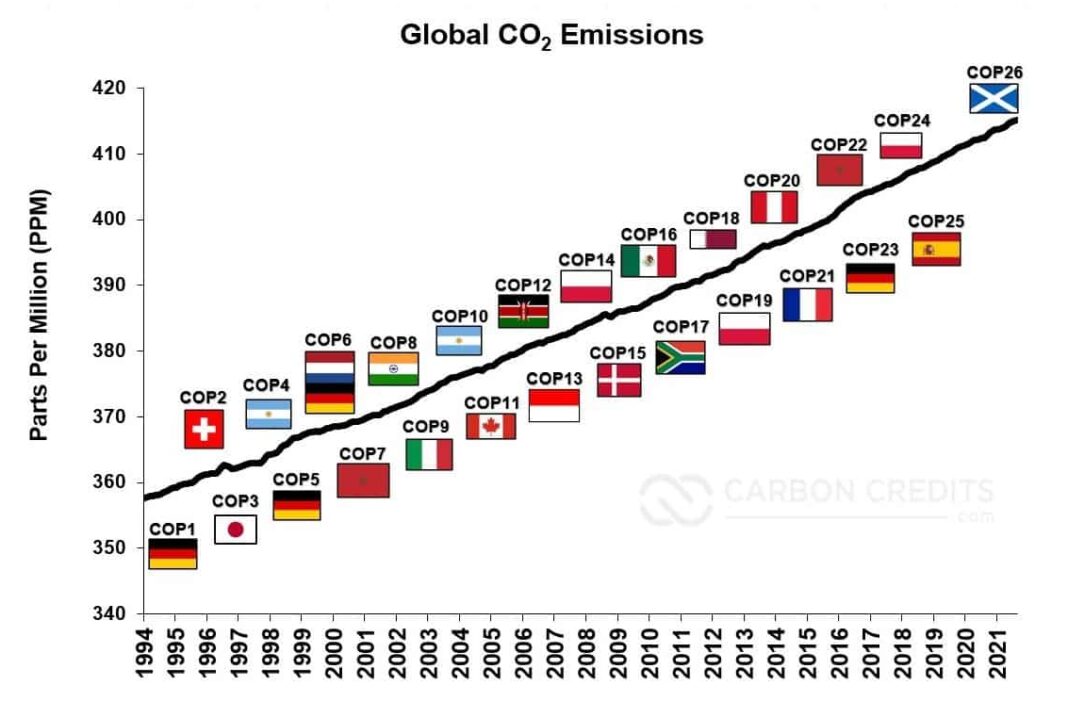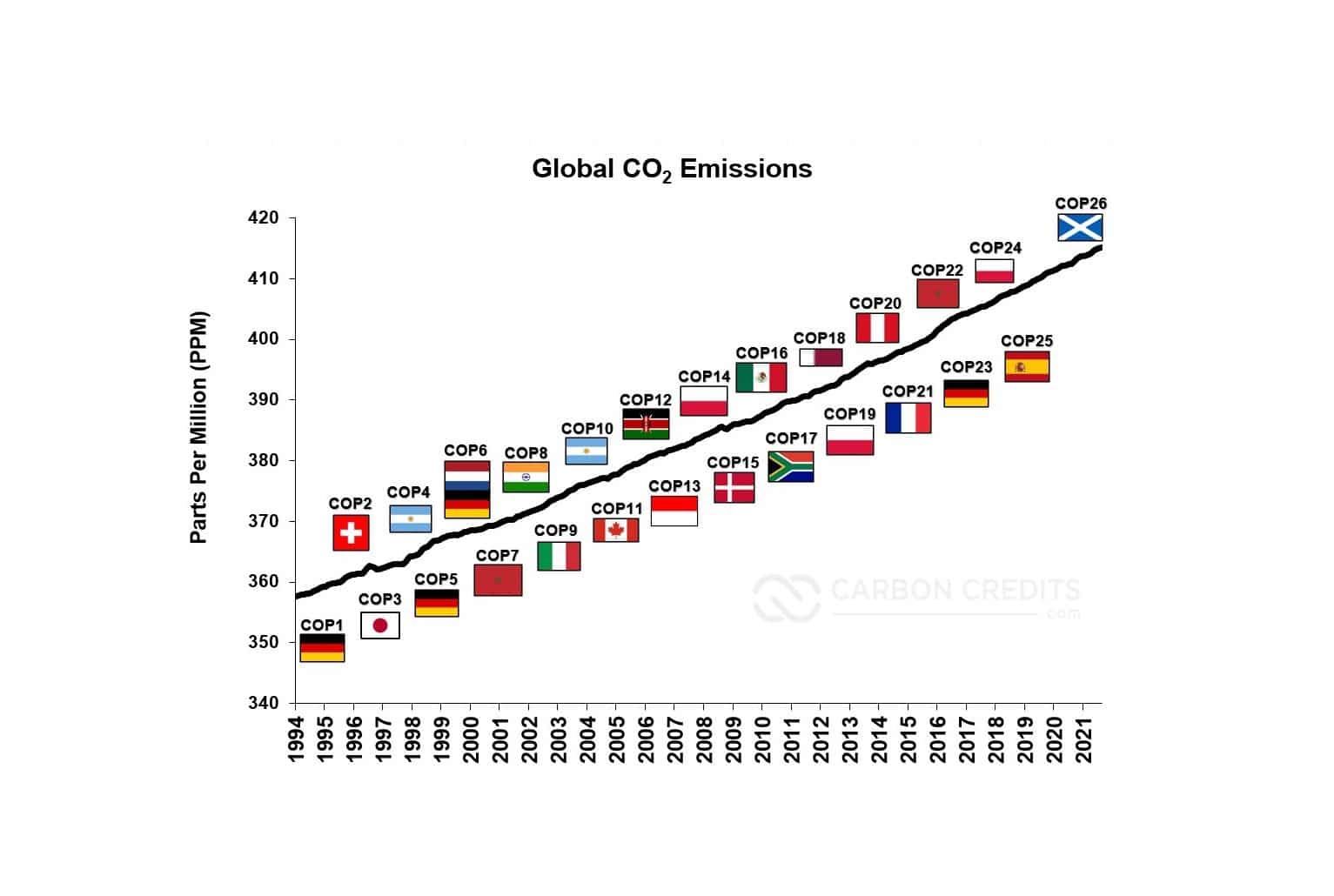Following the wake of the Montreal Protocol in 1987 the UN in conjunction with the World Meteorological Organization established the Intergovernmental Panel on Climate Change (IPCC) in 1988.
For a brief history of climate change before this, click here.
The IPCC’s first assessment report, released in 1990, would conclusively assert that human activities were the leading cause of global warming.
This report would set the foundation for the United Nations Conference on Environment and Development (UNCED) in RIO in 1992.
From that event three Conferences of the Parties or COP emerged, focused on desertification, biodiversity, and climate change.
- United Nations Convention to Combat Desertification (the UNCCD)
- The Convention on Biological Diversity (CBD)
- The United Nations Framework Convention on Climate Change (the UNFCCC)
The first international climate change conference COP was held in Berlin in 1995. With 118 parties representing UN member states in attendance.
Among other things, on the agenda for COP1 was a review of the commitments made under the UNFCCC. And one of the first decisions agreed on at the first COP was that prior commitments made under the UNFCCC would not be adequate to combat climate change.
Discussions on what exactly would be adequate would continue at COP2 in Geneva. It was decided that flexible policies for each country would be preferable over a single unified policy. Legally binding mid-term targets would be required as well.
At the same time, the IPCC’s second assessment report was accepted by the parties. Here’s the COPs in a timeline.
The Kyoto Protocol: COP3 – COP20
COP3 would take place in Kyoto in 1997, and it was there, after extensive negotiations, that the Kyoto Protocol would be implemented.
- An extension of the original UNFCCC commitments, the Kyoto Protocol was adopted that same year but wouldn’t come into effect until 2007.
Under the Kyoto Protocol, more economically developed countries would take the lead in limiting their greenhouse gas emissions. This reflected the fact that their higher level of industrialization would have given them historically higher emissions.
At the following meeting, COP4 in Buenos Aires in 1998, final details regarding the Kyoto Protocol were supposed to be resolved. But the remaining issues proved to be too difficult for the parties to agree.
As a result, these negotiations would carry forward into a “Plan of Action” through COP5 in Bonn in 1999 and COP6 in The Hague in 2000.
COP’s Plan of Action
Though this Plan of Action was supposed to be wrapped up by COP6, talks fell through at the conference and had to be continued in a “part 2” COP6 in 2001.
During this second COP6 meeting, which took place after the Bush administration withdrew the United States from the Kyoto Protocol. A number of key agreements were made there, such as those regarding the Clean Development Mechanism (CDM) that the Kyoto Protocol is notable for.
-
Under the CDM, the private and public sectors of high-income nations have the opportunity to purchase carbon credits from projects in middle and lower-income nations.
Further details regarding the Kyoto Protocol would be finalized at COP7 in Marrakech later that same year. This capped off the Plan of Action that had been established three years earlier at COP4.
COP8 in New Delhi in 2002 and COP9 in Milan in 2003 set some provisions. They require the more economically developed nations to assist developing countries in adapting to climate change through the transfer of technology.
Then came the ten-year anniversary of the climate change conference, the COP10 in Buenos Aires in 2004. It saw another special Plan of Action to continue supporting developing countries.
This was also the first conference where the parties began discussing the next step in their emission reduction efforts past the Kyoto Protocol, which was scheduled to end in 2012.
- COP11, held in Montreal in 2005, was where the Kyoto Protocol was finally entered into force for the initial commitment period of 2008-2012.
Another Action Plan was devised. This time, the plan is to extend the Kyoto Protocol beyond its initial end date in 2012. Also, to negotiate even deeper cuts in GHG emissions.
Further refinements to the support for developing countries through processes such as the Clean Development Mechanism were made during COP12 in Nairobi in 2006.
During COP13 at Bali in 2007, a timeline and structure for negotiation of what to do after the expiry of the Kyoto Protocol was laid out through the Bali Action Plan. And a new working group was established to manage said negotiations.
This is the first conference held following the commencement of the Kyoto Protocol. The main issue discussed at COP14 in Poznań in 2008 was for a replacement agreement that would succeed the Protocol.
Going into COP15 at Copenhagen in 2009, the primary aim of all parties in attendance was to hash out an agreement for 2013 onwards.
However, the countries present could not come to an accord. And so, their discussions were continued at the next COP.
COP16 in Cancún saw the establishment of a “Green Climate Fund”. Under this Fund, the wealthier nations were supposed to provide US$100 billion to developing countries each year. The aim is to assist them in mitigating the impact of climate change.
However, agreement for the actual funding of this $100 billion a year was not actually reached.
COP17 in Durban in 2011 marked the beginning of negotiations for what would become the successor to the Kyoto Protocol – the Paris Agreement. It was set to be adopted in 2015 and go into effect after 2020.
Discussion also continued on an extension of the Kyoto Protocol. It covers the period between the end of the initial commitment period in 2013, and the start of the Paris Agreement in 2021.
COP18 took place at Doha in 2012, during the last year of the initial Kyoto Protocol commitment period. Negotiations were successful here to create the Doha Amendment to the Kyoto Protocol. It created a second commitment period from 2012 to 2020.
Unfortunately, a number of major countries such as the U.S., Canada, China, India, Japan, and Russia either did not commit to this second period, or were not subject to emissions reductions under the Protocol. This makes the Doha Amendment somewhat of a stopgap measure.
The next COP, COP19 in Warsaw in 2013, continued discussions regarding the proposed international agreement in 2015. But the talks were marred by a series of walkouts from poorer developing countries. They accused the most industrialized countries of putting too much of the burden on them.
- Further groundwork was laid for what would become the Paris Agreement at COP20 in Lima in 2014.
The Paris Agreement: COP21 – COP26+
Discussions that first began at COP17 in Durban would finally conclude at COP21 in Paris in 2015. This COP established what we now know as the Paris Agreement.
The Agreement was ratified by 194 parties – all but four member nations of the UNFCCC. Its primary goal is to limit global warming below 2°C above pre-industrial levels and, ideally, below 1.5°C if possible.
In order to achieve this, global emissions would roughly need to halve by 2030, and be completely net zero by 2050.
The Paris Agreement consists of rolling five-year periods in which each country agrees to a reduction plan. It’s what they referred to as their Nationally Determined Contribution (NDC).
- A new NDC must be submitted every five years, and each NDC must be more ambitious than the last.
Set up this way, the Paris Agreement is the “final” international climate change agreement for the foreseeable future. It was also the first one to be legally binding and hence enforceable.
Several countries and even oil majors like Shell facing climate litigation on the grounds of violating the Paris Agreement.
The Paris Agreement entered into force in November 2016. This is when further work on the actual implementation and details of the Agreement would take place at COP22 in Marrakech later that month. Then COP23 was held in Bonn the next year.
Rules governing the implementation of the Paris Agreement were mostly settled at COP24 in Katowice in 2018. One notable exception was Article 6 of the Agreement, the rules covering the establishment and management of an international carbon market.
Discussion over the particulars of Article 6 was the primary focus of COP25 in Madrid in 2019. Yet, the issue went unresolved. Talks were supposed to resume at COP26 in 2020, but the conference was delayed due to the COVID-19 pandemic.
It wouldn’t be until 2021 in Glasgow that the issue of Article 6 of the Paris Agreement would finally be settled at COP26, setting the foundation for an international carbon market.
What to Expect From COP 27 in 2022
Up next on the calendar is COP27. It will take place in Sharm El Sheikh in Egypt from Sunday, November 6 to Friday, November 18.
Usually, there are dozens of topics of discussion at each annual COP. The abbreviated summary provided above highlights just one or two major points of interest from each previous conference. However, there are often several different minor agreements and details addressed at each COP.
Likewise, there are a couple of different things we’ll probably see on the agenda for COP27:
- The IPCC’s sixth assessment report was released just earlier this year. And it’s expected that the parties will recognize the report’s results.
- There is scheduled to be a “global stocktake” of climate action at COP28 in Dubai next year. The aim is to measure the actual progress made by the Paris Agreement towards combating climate change. The focus will be on results at COP 27, and whether or not countries are actually hitting their targets.
- Back at COP16 in Cancún, a Green Climate Fund was established that was supposed to provide $100 billion a year in climate assistance. However, this fund still remains some $17 billion short. And this will likely be addressed once again as it has been regularly since 2010.
- “Loss and damage”, or permanent harm caused by climate change is a term that was coined back at COP18 in 2012. An example is sea level rises rendering areas uninhabitable. There’s an expected financial responsibility for the wealthy industrialized nations, who were the primary drivers of climate change in the past, to assist lesser developed nations suffering from loss and damage; but the exact particulars remain unresolved.
- There has been the recent bouts of inflation and food/energy shortages. So, expect a further focus on climate finance particularly from developing nations.
- Taking all current climate change pledges and NDCs into account, it’s been calculated that global warming will still exceed the 2°C target set by the Paris Agreement. Expect to see further rhetoric revolving around the Paris Agreement’s mechanism of increasing ambition.
All in all, the key themes of COP27 will likely revolve around Implementation and Climate Finance.



